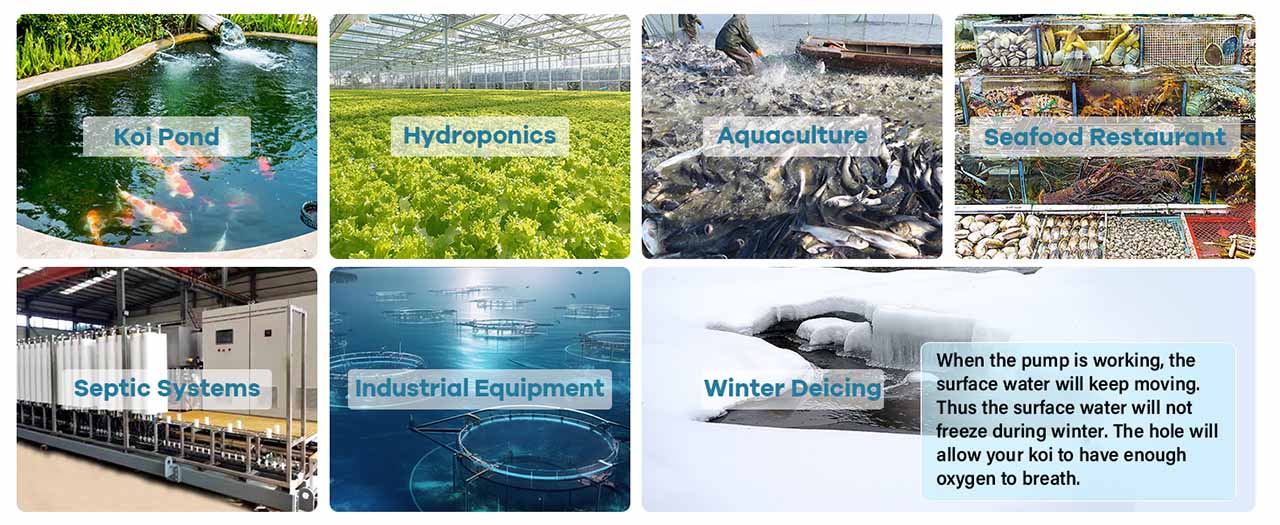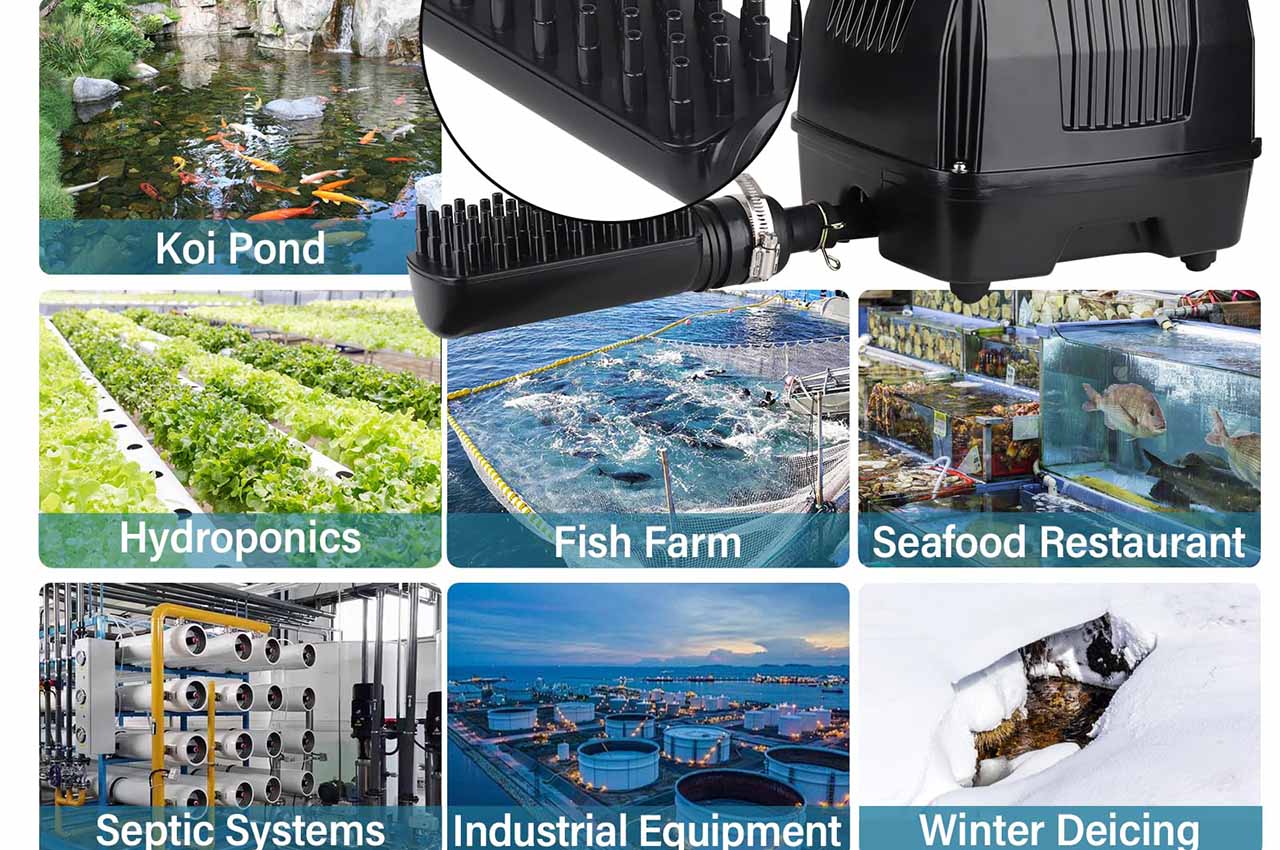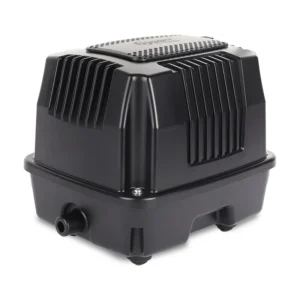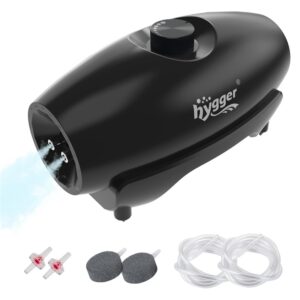Big air pumps help in large facilities in various industries. These pumps improve oxygenation, help to move the liquid, and keep the perishable items fresh. This article will answer what high-flow air pumps are and their different use cases in big air pump aquariums.
Content Table
What is a high-flow air pump? How do you select a suitable pump, and list some of the best high-flow air pumps? How to control the flow is also a part of the discussion. I’ve also suggested one of the best indoor and outdoor high-flow pumps. Now, scroll down and enjoy the discussion.

Big air pump aquarium
What Is a High Flow Air Pump
High-flow air pumps efficiently deliver a large air or oxygen volume at relatively low pressure. These are the best where strong and continuous airflow is required, i.e., hydroponics, ponds, aquariums, etc. In the following, some high-flow air pumps are discussed.
Air-Driven Pumps
Pneumatic or air-driven pumps help to move the fluid through the pipes at a pressure of up to 20,000 PSI. It works in Oil, water, and chemical industries.
Linear Diaphragm Air Pumps
Armature or linear diaphragm air pumps work on the principle of electromagnetism to move the piston or diaphragm. Durability, efficiency, and quiet operation are a few salient features of this positive displacement pump. It helps in sewage aeration, aquaculture, pond aeration, medical devices, vacuum or pressure generators, etc.
Microblowers
Microblowers are small and lightweight air pumps. They produce high airflow and pressure on a limited budget and occupy small space. Electronic cooling, fuel cells, subsurface remediation, etc., are the practical applications of micro blowers.
What Can a High-Flow Air Pump Do?
High-flow air pumps have numerous applications. Here are a few applications of this pump.
Ponds
These high-flow air pumps improve the oxygenation of the pond. It optimizes the fish’s health and increases the beneficial bacteria count in the ponds. It avoids stagnation in the pond, results in algae reduction, and prevents stratification.
Restaurant Seafood Tanks
These pumps provide oxygen to live seafood, i.e., fish, lobsters, etc. It helps to keep them fresh and alive. Moreover, higher oxygenation reduces stress and maintains seafood quality in restaurant seafood tanks.
Aquariums
In large aquariums, adjustable high-flow air pumps help in several ways. This pump increases the efficiency of the sponge and under-gravel filters. This results in improved oxygenation. It enhances the water quality by catalyzing the gas exchange, i.e., oxygen and carbon dioxide, at the tank surface. Moreover, it also improves the plants’ health, which optimizes overall tank health.
Fishing
Fishing is done for seafood, tournaments, or recreation. When fishermen go far in the sea, they use bait tanks to store the live fish. A rechargeable air pump kit helps keep the fish alive and healthy until the boat reaches the coast. Moreover, they keep the fish fresh in bait tanks in fishing tournaments.

High-flow air pump applications
Hydroponics
Hydroponics systems require 2 liters of air per minute for the nutrient solution. Oxygen pumps do this job. Moreover, it optimizes the oxygen in the air zone and enhances the nutrient uptake and growth rate. It keeps the water in motion and avoids diseases, i.e., root rot.
Aquaponics
Aquaponics requires continuous high airflow. Experts suggest using linear diaphragm pumpsas they are energy-efficient and quiet. They input sufficient oxygen into the system to improve the fish’s health and enhance the plant roots’ health. It helps beneficial bacteria that break down the waste in the system.
Fish Farms
Fish farms produce a big chunk of edible fish. High-flow AC DC air pumps help in fast growth, improve water quality, and mitigate disease risk. In summer, a high-flow air pump is a blessing as it avoids oxygen depletion in the tank or pond.
What Air Pump Is Best for 10000 Liter Fish Farming?
Suitable pump selection has many selection factors. These factors are the following.
| Factor | Description |
| Flow rate | 100 to 200 liters per minute (LPM) |
| Noise level | Linear pump: Residential and working areas |
| Piston pump or blower: remote areas | |
| Power consumption | Energy efficient under continuous running conditions. |
| Maintenance | Low maintenance High reliability Easily available spare parts |
| Durability | Solid construction and good warranty |
Here are some types of pumps that you can use in your fish farms.
Diaphragm Air Pumps
These pumps are suitable for small to medium-sized tanks with moderate stocking density. These are the best due to their reliability, efficient energy consumption, and almost quiet operation. They offer a 100 to 150 liter per minute flow rate.
Piston Air Pumps
Piston air pumps are suitable for large tanks. These pumps offer a high flow rate, go well with deep tanks, and are reliable under continuous usage. They offer an 80 to 150 liter per minute flow rate.
Linear Air Pumps
Large tanks, fish farms, and outdoor water facilities suit the linear air pumps. They offer a 150 to 200-liter per-minute flow rate in the facility. Their energy efficiency, quiet operation, and durability make them fit for 10,000-liter fish farms.
Blower Air Pumps
Very high stocking density or multiple tank systems fit with a blower air pump as they offer a 200+ LPM flow rate.

Air pump for outdoor fishing
hygger High Flow Air Pump
Hygger offers a solution to the airflow problem with its hygger 125 High-Flow Air Pump. It’s a powerful, energy-efficient, and well-designed device that you can use in multiple ways. Like ponds, seafood tanks, aquariums, fish farms, hydroponics, and septic tank systems.
Design
It’s a sturdy gadget that will help you in the long run. Here are the different design aspects.
- It has a built-in copper motor, which provides high energy efficiency, long life, and durability.
- It offers multi-outlet diverter valves that enable you to have multiple connections. You can simultaneously connect with air stones and tubing. You can use it in numerous tanks at once.
- It has an expanded shell surface and filtered air holes, which offer enhanced heat dissipation.
- It operates quietly as it has multiple noise-reduction layers. It has a thick aluminum alloy shell, silicone feet, rubber buffers, and a magnetic drive motor. All of these make it quieter.
Features
Copper Motor
Its copper motor makes it suitable for continuous use.
Energy Efficient
It is energy efficient.
Quiet Operation
It has a noise-reducing and shockproof design that makes it quieter than other same-flow air pumps.
Waterproof
It’s waterproof, so you can use it in outdoor facilities.
Multiple Application
You can use it for various applications, i.e., fish ponds, aquariums, seafood tanks, hydroponic systems, and septic tanks.
Outstanding Qualities
Multiple Power Options
These are available in multiple power options.
| Power (Watt) | Flow rate (GPH) | Flow rate (LPM) | Pressure (MPa) |
| 18 | 475 | 30 | 0.030 |
| 25 | 800 | 50 | 0.030 |
| 40 | 1270 | 80 | 0.030 |
| 105 | 2550 | 160 | 0.042 |
Long Life
It offers long service life due to its sturdy, waterproof, and excellent heat dissipation design.
Easy installation and maintenance
It’s easy to install due to a clear installation guide and replaceable diaphragms bring ease in maintenance.
Can an Air Pump Be Too Strong for a Fish Tank?
Yes, a big air pump can be strong for a fish tank. This extra power causes problems, i.e., over-energy consumption, high initial cost, and frequent maintenance. Moreover, fish face stress as they are unable to eat and swim. Moreover, strong airflow also affects plant growth. In brief, it disrupts the tank ecosystem.
How to Know about Strong Pump
- Smaller and slower fish face difficulty in swimming due to excessive water movement.
- Frequent hiding, erratic swimming, and avoiding the surface also indicate that you need to check your air flow rate.
- Plant uprooting and disturbance in the substrate also indicate a strong flow.
- If your under-gravel and sponge filters are not working efficiently, it might be due to a high airflow.
How to Set Suitable Air Flow for Various Tanks?
1 gallon per hour air flow rate for each gallon of water in your water facility.
| Capacity (gallons) | Suitable Pump (minimum GPH) | Adjustment Tips |
| 20 | 20 | Adjust the flow with the air valve |
| 30 | 30 | Use air stone or bubble wand |
| 40 | 40 | Place air stones away from plants and fish’s hiding spots. |
| 50 | 50 | Adjust it with the flow control valve Use a dual outlet pump for even distribution. |
| 75 | 75 | Use multiple air stones to split the flow |
| 100 | 100 | Use multiple air stones or bubble walls |
| 125 | 125 | Use multiple air stones Place them in different spots Adjust the flow at each valve according to the requirement |
| 150 | 150 | Use a large diffuser to spread the bubbles. |
| 180 | 180 | Position the air bubbles in such a way that they minimally hinder the fish’s movement |
| 200 | 200 | Use a bubble splitter and valve for even air distribution. |
You can control the airflow rate through various methods. Here are some of the practical ways.
- Use air control valves to adjust the flow according to your requirements.
- Place the air stones so that they minimally affect the fish, i.e., in low-traffic areas.
- Use T-connectors to split the flow into multiple air stones. It’ll avoid concentrated flow.
- Use flow restrictors on air tubing to adjust the required flow rate. It will not affect the pump setting.

What is a high-flow air pump
Concluding Thoughts
High-flow air pumps supply high air in various industries. Aquariums, septic tanks, hydroponics, etc., are some examples of situations where they work continuously and efficiently. Air-driven, linear diaphragm, and Microblowers are a few types of high-flow air pumps. Strong flow causes a disturbance for small tanks, and you can control it with air-control valves, T-connectors, and flow restrictors. The hygger high-flow pump is for the best and longest support for your indoor and outdoor water facilities.


Leave a comment